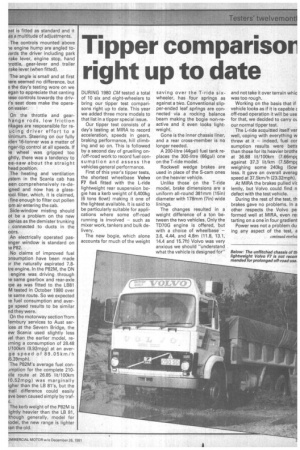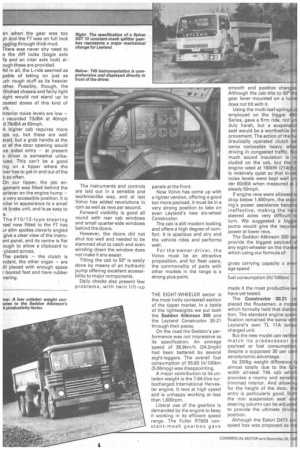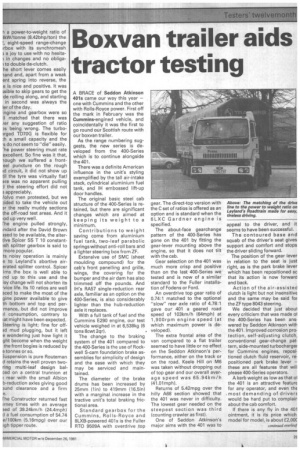Tipper comparisor right up to date
Page 27

Page 28

Page 29

If you've noticed an error in this article please click here to report it so we can fix it.
DURING 1980 CM tested a total of 10 six and eight-wheelers to bring our tipper test comparisons right up to date. This year we added three more models to that list in a tipper special issue.
Our tipper test consists of a day's testing at MIRA to record acceleration, speeds in gears, braking performance, hill climbing and so on. This is followed by a second day of gruelling on/off-road work to record fuel consumption and assess the vehicles general performance.
First of this year's tipper tests, the shortest wheelbase Volvo F7 6x4 fitted with the L-ride lightweight rear suspension bogie has a kerb weight of 6,400kg (6 tons 6cwt) making it one of the lightest available. It is said to be particularly suitable for applications where some off-road running is involved — such as mixer work, tankers and bulk delivery.
The new bogie, which alone accounts for much of the weight saving over the T-ride sixwheeler, has four springs as against a tWo. Conventional slipper-ended leaf springs are connected via a rocking balance beam making the bogie non-reactive and it even looks lightweight.
Gone is the inner chassis liner, and a rear cross-member is no longer needed.
A 200-litre (44ga1) fuel tank replaces the 300-litre (66gal) one on the T-ride model.
Rockwell wedge brakes are used in place of the S-cam ones on the heavier vehicle.
Unlike those. on the T-ride model, brake dimensions are a uniform all-round 381mm (15in) diameter with 178mm (7in) wide
The changes resulted in a weight difference of a ton between the two vehicles. Only the TD7OG engine is offered, but with a choice of wheelbase 3.6, 4.44, and 4.8m (11.8, 13.1, 14.4 and 15.7ft) Volvo was very anxious we should "understand what the vehicle is designed for" and not take it over terrain whic was too rough.
Working on the basis that if vehicle looks as if it is capable c off-road operation it will be use for that, we decided to carry oL our normal tipper test.
The L-ride acquitted itself ver well, coping with everything w threw at it — indeed, fuel cor sumption results were bett€ than those for its heavier brothE at 36,88 lit/100km (7.66mpc against 37.3. lit/km (7.58mpc weighing some 240kg (5cw less. It gave an overall averag speed at 37.5km/h (23.32mph).
At MIRA the brakes pulled vic lently, but Volvo could find n defect with the test vehicle.
During the rest of the test, th brakes gave no problems. in a other respects the Volvo pe formed well at MIRA, even reE tarting on a one in four gradient Power was not a problem du ing any aspect of the test, a en when the gear was too lh and the F7 was on full lock igging through thick mud.
There was never any need to e the diff locks (bogie axle fs and an inter axle lock) al-ough these are provided.
All in all, the L-ride seemed as pable of taking on just as Jch rough stuff as its heavier other, Possibly, though, the flitched chassis and fairly light iight would not stand up to peated doses of this kind of Prk.
Interior noise levels are low recorded 73dBA at 40mph d 78dBA at 60mph.
A higher cab requires more ips up, but these are well iced, but a grab handle at the ar of the door opening would lye aided entry at present driver is somewhat unbaiced. This can't be a good ing on a tipper where the iver has to get in and out of the b so often.
On our tipper, the pto en'gement was fitted behind the arlever on the engine hump a very accessible position. It is nilar in appearance to a small irk brake unit, and is,as easy to e.
The F10 /12-type steering leel now fitted to the F7 has ur slim spokes cleverly angled give a clear view of the instruent panel, and its centre is flat ough to allow a clipboard to placed across.
The pedals the clutch is ,ndant, the other organ are ill placed with enough space r booted feet and have rubber ye ring.
The instruments and controls are laid out in a sensible and workmanlike way, and at last Volvo has added revolutions in rpm as well as revs per second.
Forward visibility is good all round with rear cab windows and small quarter-side windows behind the doors.
However, the doors did not shut too well and needed to be slammed shut to catch and even winding down the window does not make it any easier.
Tilting the cab to 62° is easily done by means of an hydraulic pump offering excellent accessibility to major components.
Daily checks also present few problems, with twin lift-up panels at the front.
Now Volvo has come up with a lighter version, offering a good ton more payload, it must be in a very strong position to take on even Leyland's new six-wheel Constructor.
The cab is still modern looking and offers a high degree of comfort It is spacious and airy and the vehicle rides and performs well.
For the owner-driver, the Volvo must be an attractive proposition, and for fleet users, the commonality of parts with other models in the range is a strong plus point.
THE EIGHT-WHEELER sector is the most hotly contested section of the tipper market. In a battle of the lightweights we put both the Seddon Atkinson 300 and the Leyland Constructor 30-21 through their paces.
On the road the Seddon's performance was not impressive as its specification. An average speed of 38.9km/h (24.2mph) had been bettered by several eight-leggers. The overall fuel consumption of 55.83 lit/100km (5.06mpg) was disappointing.
A major contribution to its unladen weight is the 7.64-litre turbocharged International Harvester engine. It revs at high speed and is unhappy working at less than 1,600rpm.
Liberal use of the gearbox is demanded by the engine to keep it working in its efficient speed range. The Fuller RT609 constant-mesh gearbox gave smooth and positive chan Although the cab tilts to 50° gear lever mounted on a tu does not tilt with it. !
Using the multi-leaf spring a1 employed on the bigger Series, gave a firm ride, not Or• duly harsh, but a suspen or seat would be a worthwhile in-. provement The action of the 6w draulidally operated clutch 0411. came noticeable heavy wt!e driving in congested traffic. NO much sound insulation is eluded on the cab, but th engine rated at 160kW (214 is relatively quiet so that innoise levels were kept well der 80dBA when measured steady 50mph.
If engine revs were allowe drop below 1,400rpm, the st ing's power assistance bee ineffective, making the t steered axles very difficult turn. We suggested a hi pump would give the requi power at lower revs.
The Seddon Atkinson 300 provide the biggest payloa any eight-wheeler on the ma which using our formula of: gross carrying capacity x a age speed fuel consumption (lit/100km) made it the most productive have yet tested.
The Constructor 30.21 jr placed the Routernan, a mod which formally held that disqn tion. The standard engine spiiefication remained the same vvitb Leyland's own TL 11A turbo, charged unit.
But the new model can neither match its predecessor o payload or fuel consumpti despite a supposed 30 per aerodynamic advantage.
Its 200kg weight difference? 1; almost totally due to the44111+ width alt-steel T45 cab •w provides a roomy and sen41 trimmed interior. And allowin0 for the height of the door, h. entry is particularly good. B.111 the non suspension seat ral
t 6 steering column can be adjuso provide the ultimate drivr position.
speed box was proposed as hill Although the Eaton D473 ix I a power-to-weight ratio of 3kW/tonne (8.42bhp/ton) the !, eight-speed range-change Irbox with its synchromesh 3 a joy to use with no hesita1 in changes and no oblige) to double de-clutch.
he short lever comes easily land and, apart from a weak ent spring into reverse, the e is nice and positive. It was 5sible to skip gears to get the de rolling along, and starting in second was always the ler of the day.
ingine and gearbox were so
II matched that there was ter any suggestion of ratio )s being wrong. The turbon-ged TD7OG is flexible for a small capacity and the 's do not seem to "die" easily. The power steering must rate excellent. So fine was it that, -lough we suffered a fronteel puncture on the rough id circuit, it did not show up til the tyre was virtually flat! ere was no apparent pulling
the steering effort did not a appreciably.
tolvo men protested, but we 1:ided to take the vehicle out Dr the really muddy sections the off-road test areas. And it rod up very well.
rho engine pulled strongly, indard after the David Brown 3sed to be available, the alterLive Spicer SS T 10 constant)sh splitter gearbox is said to more popular.
ts noisy operation is mainly
e to Leyland's abortive airorated splitter control. Spicer ims the box is well able to Ind up to this use and the isy change will not shorten its -vice life. Its 10 ratios are well aced to make the most of the gine power available to give th bottom and top end permance, but did not improve )1 consumption, contrary to at might have been expected. steering is light; fine for off)cl mud plugging, but it left
e wondering just how light it ght become when the weight the front bogies is reduced by e tonnes or so.
Suspension is pure Routeman d retains the well proven tworing multi-leaf design balced on a central trunnion at rear with the small Albion b-reduction axles giving good mind clearance and a firm e.
rhe Constructor returned fast rrney times with an average .aed of 39.24km/h (24.4mph) d a fuel consumption of 54.74 e/100km (5.16mpg) over our Jgh tipper route.




































